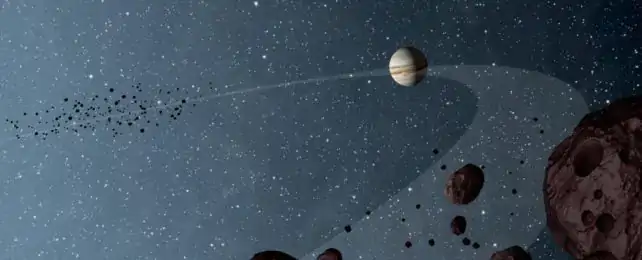Between these swarms, known collectively as trojans, we've identified more than 12,000 asteroids to date, but there's a curious mystery that has baffled scientists: The leading swarm, known as the Greeks or L4 swarm, has significantly more asteroids than the trailing Trojans or L5, even though both groups seem equally stable.
Now a team of scientists has an answer: a change in Jupiter's distance from the Sun in the early days of the Solar System. Specifically, moving from a closer proximity to its current orbit.
"We propose that an outward, in terms of distance to the Sun, fast migration of Jupiter can distort the configuration of the Trojan swarms, resulting in more stable orbits in the L4 swarm than in the L5 one," says astronomer Jian Li of Nanjing University in China.
"This mechanism, which temporarily induced different evolution paths for the two asteroid groups that share the orbit of Jupiter, provides a new and natural explanation for the unbiased observation, that the L4 asteroids are about 1.6 times more than the asteroids in the L5 swarm."
L4 and L5 refer to Lagrange points, gravitationally stable points that occur during two-body interactions. Each two-body system has five Lagrange points, where the gravitational interaction between the two bodies balances with the centripetal force required for a small body to move with them.
Three of these points lie along the line connecting the two large bodies. The remaining two, L4 and L5, share the orbital path of the smaller of the two bodies, L4 leading and L5 trailing.
Jupiter's Greeks and Trojans, according to decades of research, should be similarly numerous. The two populations have almost identical properties related to their stability and survivability, yet the Greeks far outnumber the Trojans. To figure out why, Li and his colleagues decided to model Jupiter's early evolution based on something called early giant-planet instability.
This theory suggests that Jupiter formed at a different location from its current position but was booted out by a gravitational disruption from another planetary body early in the Solar System's history.
The Grand Tack hypothesis, which could resolve several problems with the Solar System, suggests that Jupiter moved inwards towards the Sun and then moved back out again to its current distance.
According to the team's model, the asymmetry in the trojan population can be replicated during a rapid outward migration, during which Trojans are lost. Greeks, on the other hand, are lost during the inward migration. The team's model suggests that Jupiter migrated outwards more than inwards, resulting in a higher population of Greeks.
This is a different scenario from a 2019 study that found the asymmetry was the result solely of an inward migration, but it lines up better with the Grand Tack hypothesis.
The model, as it stands, is a pretty interesting starting point, but the researchers note that it is relatively rough. Future research could work on producing a more finely detailed model to discover if the number, order, or length of migrations is relevant to the number of trojans.
The current work didn't take into account the potential effects of Saturn, Uranus, or Neptune, either. For a more accurate result, these bodies could be included.
And identifying more trojans will give a more accurate description of the population of these objects, which will also help refine future analyses, the researchers say. But the line of inquiry looks promising.
"The characteristics of the current Solar System hold as-yet unsolved mysteries into its formation and early evolution," says astronomer Nikolaos Georgakarakos of New York University Abu Dhabi in the United Arab Emirates.
"The ability to successfully simulate an event from an early stage of the Solar System's development and apply those results to modern-day questions can also be a key tool as astrophysicists, and other researchers work to learn more about the dawn of our world."
The research has been published in Astronomy & Astrophysics.



